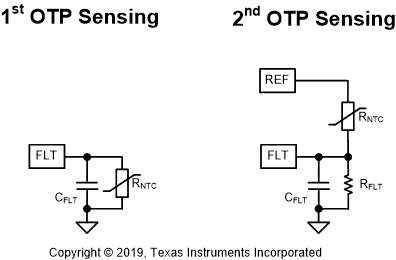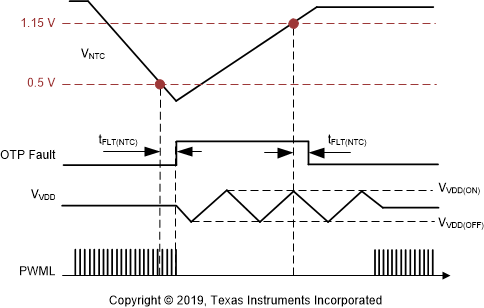ZHCSOY9 december 2021 UCC28781
PRODUCTION DATA
- 1
- 1 特性
- 2 应用
- 3 说明
- 4 Revision History
- 5 Pin Configuration and Functions
- 6 Specifications
-
7 Detailed Description
- 7.1 Overview
- 7.2 Functional Block Diagram
- 7.3
Detailed Pin Description
- 7.3.1 BUR Pin (Programmable Burst Mode)
- 7.3.2 FB Pin (Feedback Pin)
- 7.3.3 REF Pin (Internal 5-V Bias)
- 7.3.4 VDD Pin (Device Bias Supply)
- 7.3.5 P13 and SWS Pins
- 7.3.6 S13 Pin
- 7.3.7 IPC Pin (Intelligent Power Control Pin)
- 7.3.8 RUN Pin (Driver and Bias Source for Isolator)
- 7.3.9 PWMH and AGND Pins
- 7.3.10 PWML and PGND Pins
- 7.3.11 SET Pin
- 7.3.12 RTZ Pin (Sets Delay for Transition Time to Zero)
- 7.3.13 RDM Pin (Sets Synthesized Demagnetization Time for ZVS Tuning)
- 7.3.14 XCD Pin
- 7.3.15 CS, VS, and FLT Pins
- 7.4
Device Functional Modes
- 7.4.1 Adaptive ZVS Control with Auto-Tuning
- 7.4.2 Dead-Time Optimization
- 7.4.3 EMI Dither and Dither Fading Function
- 7.4.4 Control Law Across Entire Load Range
- 7.4.5 Adaptive Amplitude Modulation (AAM)
- 7.4.6 Adaptive Burst Mode (ABM)
- 7.4.7 Low Power Mode (LPM)
- 7.4.8 First Standby Power Mode (SBP1)
- 7.4.9 Second Standby Power Mode (SBP2)
- 7.4.10 Startup Sequence
- 7.4.11 Survival Mode of VDD (INT_STOP)
- 7.4.12
System Fault Protections
- 7.4.12.1 Brown-In and Brown-Out
- 7.4.12.2 Output Over-Voltage Protection (OVP)
- 7.4.12.3 输入过压保护 (IOVP)
- 7.4.12.4 FLT 引脚上的过热保护 (OTP)
- 7.4.12.5 CS 引脚上的过热保护 (OTP)
- 7.4.12.6 可编程过功率保护 (OPP)
- 7.4.12.7 峰值功率限制 (PPL)
- 7.4.12.8 输出短路保护 (SCP)
- 7.4.12.9 过流保护 (OCP)
- 7.4.12.10 External Shutdown
- 7.4.12.11 Internal Thermal Shutdown
- 7.4.13 Pin Open/Short Protections
-
8 Application and Implementation
- 8.1 Application Information
- 8.2
Typical Application Circuit
- 8.2.1 Design Requirements for a 60-W, 15-V ZVSF Bias Supply Application with a DC Input
- 8.2.2 Detailed Design Procedure
- 8.2.3 Application Curves
- 9 Power Supply Recommendations
- 10Layout
- 11Device and Documentation Support
- 12Mechanical, Packaging, and Orderable Information
7.4.12.4 FLT 引脚上的过热保护 (OTP)
UCC28781 使用连接到 FLT 引脚的外部 NTC 电阻器 (RNTC) 对转换器热点附近的热关断温度进行编程。NTC 关断阈值 (VNTCTH) 为 0.5V,流经 RNTC 的内部电流源为 50μA,产生 10kΩ 的热敏电阻关断阈值。如果 NTC 电阻保持低于 10kΩ 状态的时间超过 50μs,则会触发 OTP 故障事件。当 NTC 电阻器远离控制器但靠近热点时,50μs 的延迟 (tFLT(NTC)) 允许在 FLT 引脚和 AGND 引脚之间放置一个滤波电容器 (CFLT)。为避免由于 RUN 变为高电平而引起的 OTP 故障,CFLT 应设计为在 tFLT(NTC) 内允许 VFLT 增加到高于 VNTCTH。另一方面,如果 NTC 电阻器靠近控制器并且没有连接到检测布线的潜在噪声耦合路径,则不需要 CFLT。
为了恢复,在 OTP 故障后,0.5V 阈值会增加到 1.15V,因此 NTC 电阻必须增加到 23kΩ 以上才能复位 OTP 故障。该阈值变化提供了安全的温度迟滞,有助于在下一次 VO 重新启动尝试之前使降低热点温度,从而降低元件的热应力。如果不使用 FLT 引脚,该引脚可保持悬空,但不能连接到 REF 引脚,因为会错误触发线路 OVP。
重输出负载条件下的散热问题是 OTP 的主要设计考虑因素,重负载工作模式 AAM 允许控制器持续处于运行状态,因此 50μs 延迟允许 VFLT 触发 OTP。根据实际的 BUR 引脚设置,在 AAM 下运行 50% 至 60% 的负载。为节省待机功耗,在 ABM、LPM、SBP1 和 SBP2 等轻负载模式的突发关断时间内禁用 50μA 电流源。然而,在这些模式下,当运行状态短于 50μs 且电流源在等待状态下被禁用时,由于没有足够的时间检测故障,因此将无法触发 OTP。因此,如果某些设计注意事项仍然要求在轻负载模式下启动 OTP,则可以通过重复使用输入 OVP 的 4.5V 阈值来进行第二个 OTP 配置。如图 7-40 所示,上 NTC 电阻器和下电阻器在 REF 引脚与 FLT 引脚之间构成一个电阻分压器。750μs 的延迟与控制器的等待状态条件无关,因此在轻负载模式下仍可触发 OTP 故障。
 图 7-40 用于在 FLT 引脚上实现 OTP 的两个连接
图 7-40 用于在 FLT 引脚上实现 OTP 的两个连接 图 7-41 FLT 引脚和 AGND 引脚之间的 NTC 的 OTP 时序图
图 7-41 FLT 引脚和 AGND 引脚之间的 NTC 的 OTP 时序图